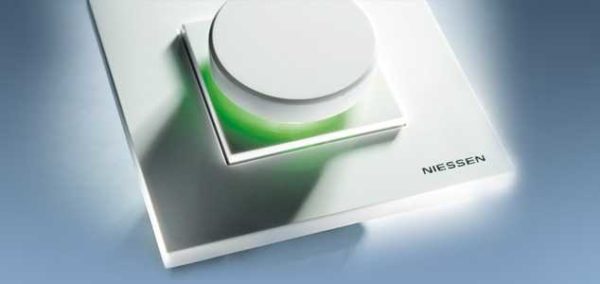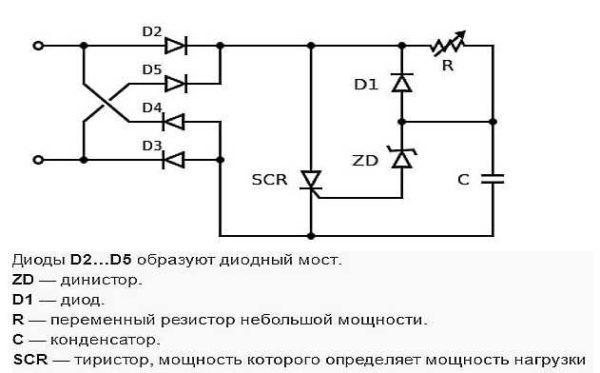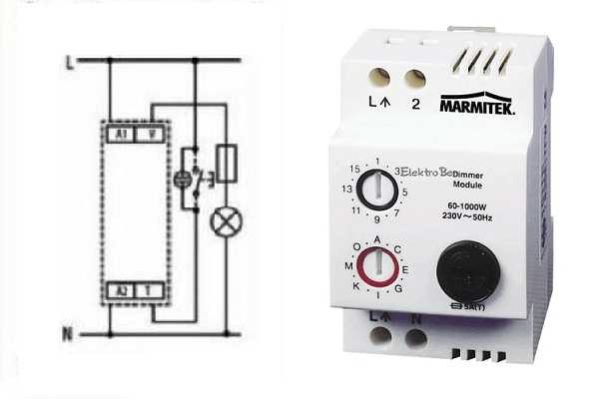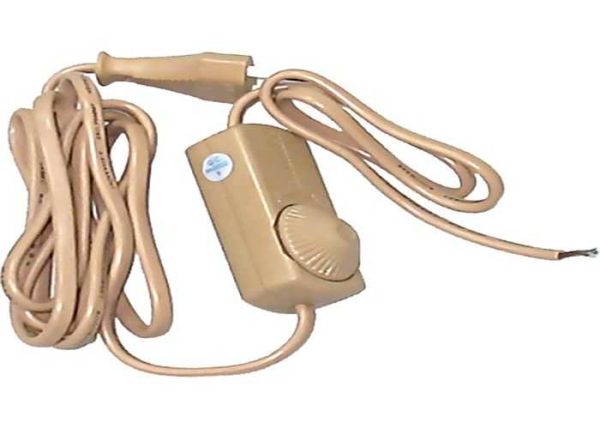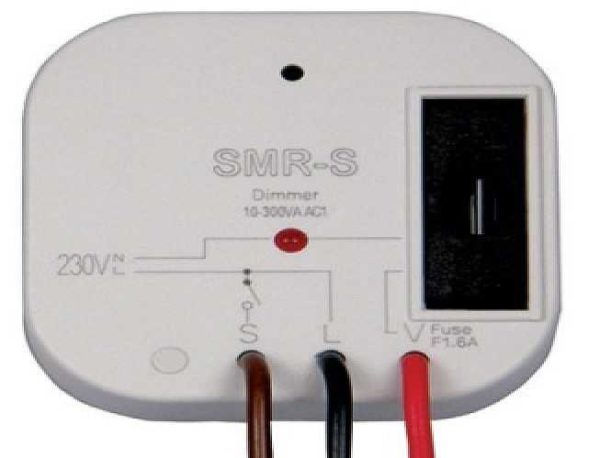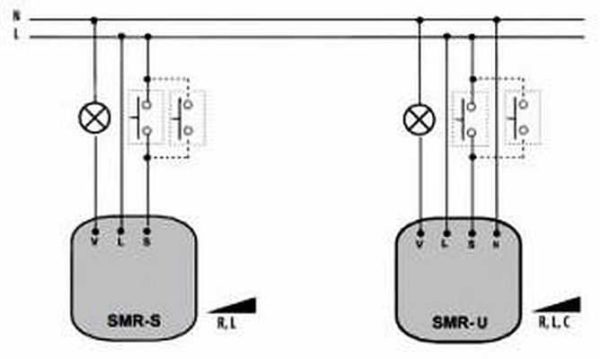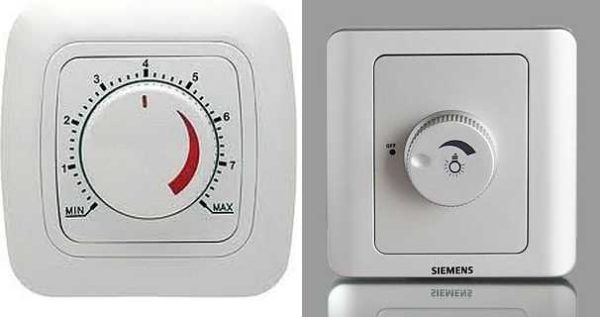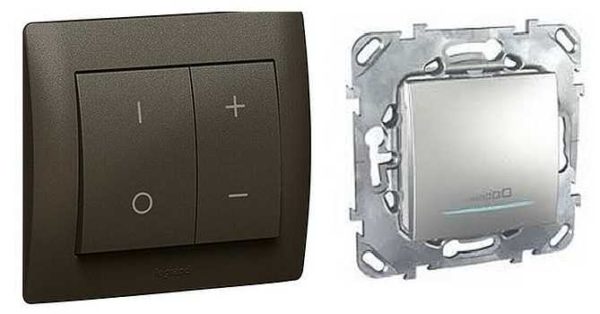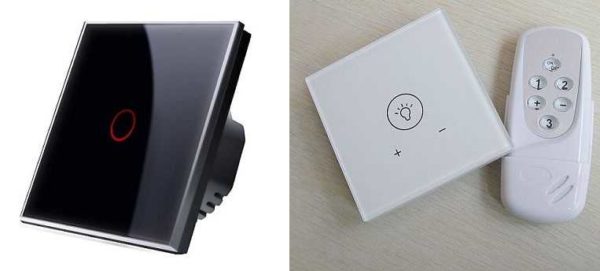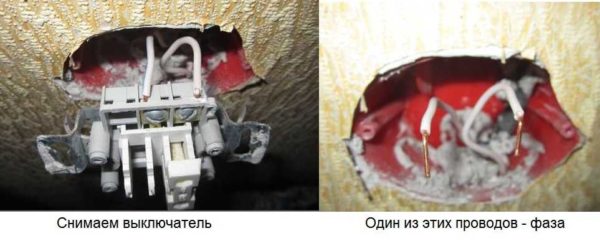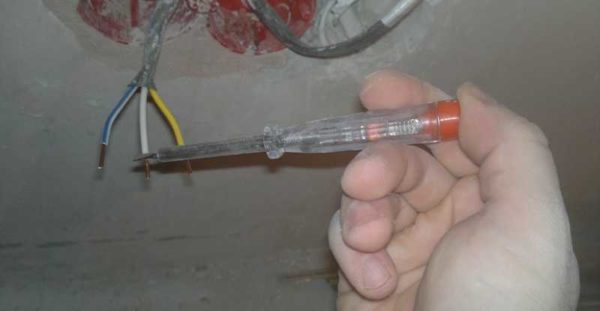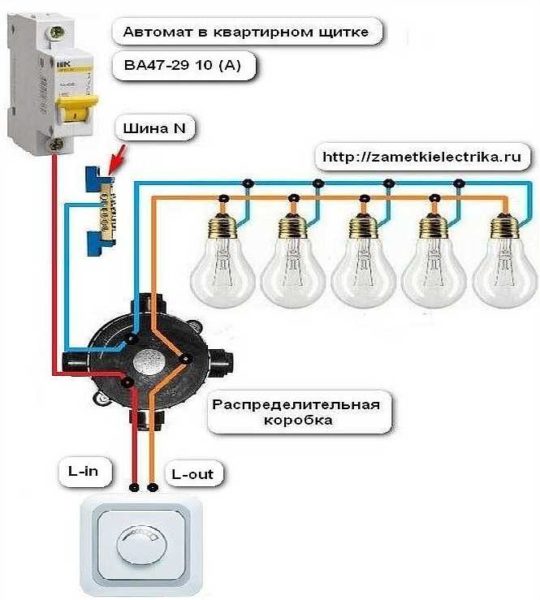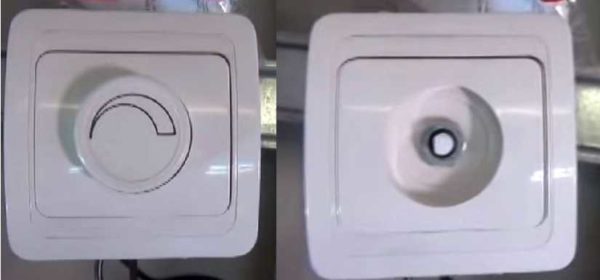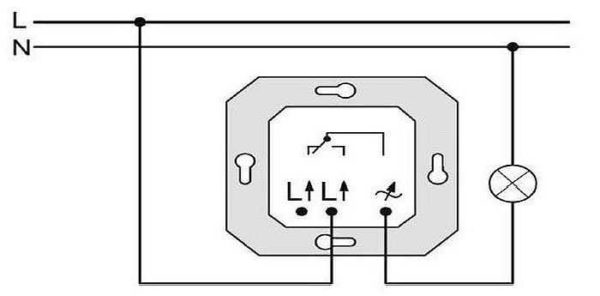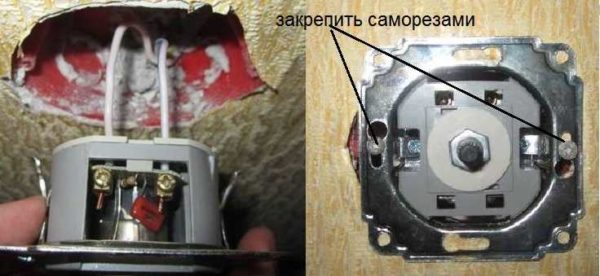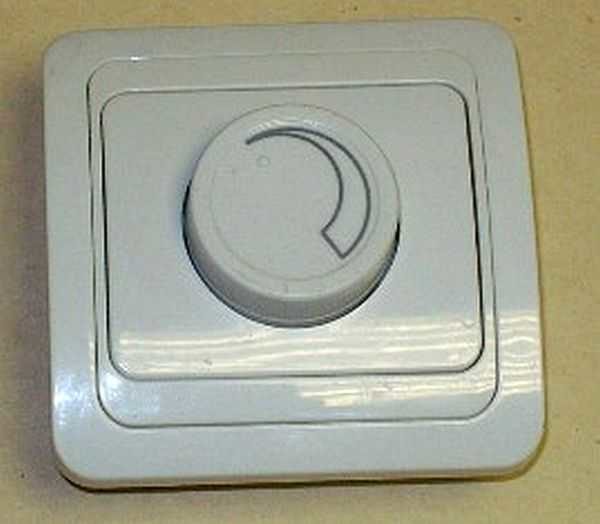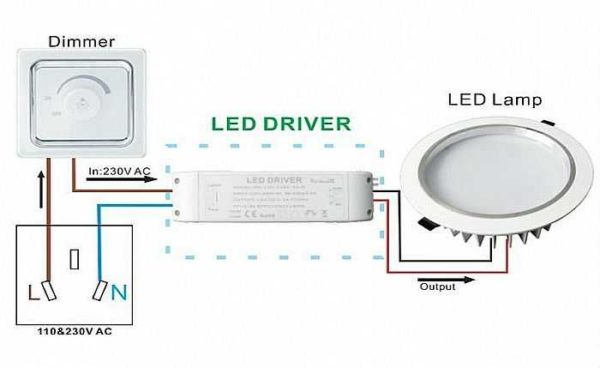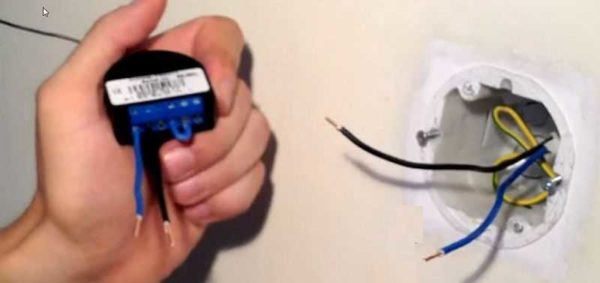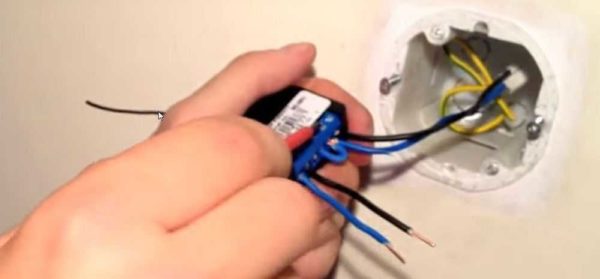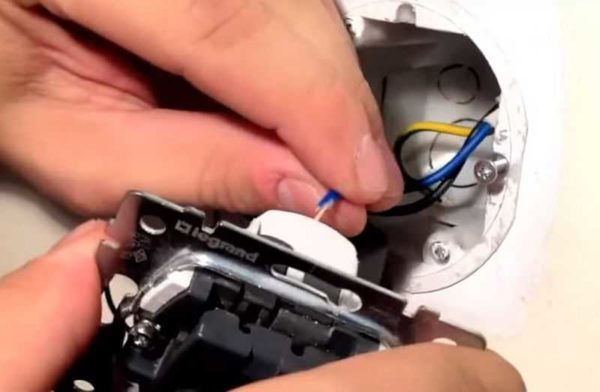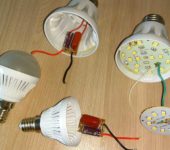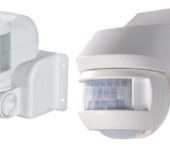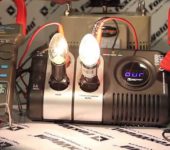Diy dimmer connection
Sometimes it becomes necessary to change the light intensity. This is done with the help of dimmers, which are more often called "dimmer" Most of the devices are mounted instead of a conventional switch - right in the same junction box, and many look similar. How to connect a dimmer with your own hands? Simple - in a phase conductor in series with the load. The regulator installation schemes are simple, you can handle it yourself.
The content of the article
Purpose and functions
Dimmers (in English dimmer) are used in everyday life to adjust the brightness of lamps, the temperature of heating devices (soldering irons, irons, electric stoves, etc.). These devices are also called dimmers or dimmers, although this is only one of the possible areas of application. They work most effectively with incandescent lamps, allowing them to extend their service life, since if there is a dimmer in the power circuit, a minimum current is supplied to the lamp when turned on. And as you know, it is the starting throws that cause them to fail.
You cannot use dimmers with transformer or switching power supplies (TVs, radios, etc.). This is due to the peculiarities of the device's operation - at the output, the signal does not look like a sinusoid, but only a part of it (the tops are cut off by keys). When this power is applied, the equipment fails.
Note! Conventional dimmers cannot be used with fluorescent lamps. Such a bundle will either not work at all, or the lamp will blink. To work with these sources, there are special devices with a different circuit. In general, ordinary dimmers can only control incandescent or LED lamps. When energy-saving ones are connected to them, the "blinking" of the light starts, and the halogen ones are simply not regulated. But you can adjust the brightness of the light for these types of lamps - there are special dimmers, but they are more expensive.
The very first dimmers were electromechanical and could only control the brightness of incandescent lamps. Modern ones can provide a whole range of additional functions:
- switching off the light by timer;
- turning on and off lighting at a certain time (presence effect, used during long trips);
- acoustic control (by clap or voice);
- the possibility of remote control;
- various modes of lamp operation - blinking, changing the temperature of light, etc.
- the ability to integrate into the "smart home" system.
The simplest dimmers still only adjust the brightness of the lighting, but this function turns out to be very useful.
Device and types
Dimmers are made on the basis of a different element base. They all have their own characteristics and disadvantages. And in order to understand what a dimmer is and how it works, you need to figure out what a particular device is made of. So, there may be options:
- Based on a rheostat (in particular a variable resistor). This is the simplest, but also the most ineffective way of dimming. Such a device gets very hot, so a cooling system is needed, it has an extremely low efficiency. Currently not in series production.
- Electronic dimmers based on triacs, thyristors, transistors. These devices cannot be used with a technique that is demanding on the shape of the power supply, since the output is something like a sine wave with clipped tops. It is also worth knowing that such circuits can generate interference that interferes with the operation of radios or equipment that is sensitive to electrical noise.Despite their shortcomings, it is electronic dimmers that are used more often - due to the low price, small dimensions and the possibility of implementing additional functions.
- Dimmers based on autotransformer. Such devices produce an almost perfect sine wave, but they are heavy and large, and require great effort to adjust. One more point: a more complex scheme leads to an increase in the cost of the regulator. However, they are also available on the market, used in places where radio interference cannot be generated or a normal form of supply voltage is required.
When choosing a device, it is not so important to know what type it belongs to, how important it is to take into account the nature of the load to which it will be connected (incandescent and LED or fluorescent and housekeeping lamps).
By the type of execution, dimmers are:
- Modular for installation in switchboard on a din rail. You can connect a dimmer of this type with incandescent lamps, halogen lamps with a step-down transformer. For ease of use, they have a remote control button or key switch. Such devices are convenient, for example, for regulating the illumination of a courtyard and an entrance gate from a house, a staircase or an entrance door.
- Dimmers on a cord. These are mini-devices that allow you to adjust the brightness of the glow of lighting devices that are plugged into an outlet - table lamps, wall lamps, floor lamps. Just be aware that they are mostly compatible with incandescent lamps.
- For installation in a back box. They are placed in an installation box under the switch (in the same box). Compatible with incandescent, LED, halogen step-down and electronic transformers. They are controlled by a button that is placed over the device or connected to the “smart home” system.
- Monoblock. In appearance, it is very similar to an ordinary switch, it is placed in the same installation box, it is possible instead of a switch. They are included in the phase circuit break (diagrams below). This type has a great variety of species. With which lamps such a dimmer can be connected, it should be indicated on the case, but if it is an electronic circuit, then they work with incandescent lamps and some halogen and LED lamps (which are dimmable or there is a corresponding sign). Can be controlled:
- With a rotary dial (rotary dimmers). The light is turned off by turning the dial to the extreme left position. The disadvantage of this model is that it is impossible to fix the last illumination value. When switched on, the minimum brightness is always set.
- Rotary-push. They are similar in appearance, but turning on / off occurs by pressing the dial, and adjustment by turning it.
- Keyboards. In appearance they are very similar to conventional switches. Turning on / off the light is standard - by flipping the key, and the adjustment starts after holding the key down for more than 3 seconds. there are models in which switching on / off occurs with one key, and adjustment with another.
- Sensory. All control takes place by touching the screen. These models are the most reliable - no mechanical parts, almost nothing to break.
In private houses and apartments, monoblock dimmers are most often installed. A modular design can still come in handy in a house - to change the brightness of the illumination of the local area with the ability to control it from home. For such cases, there are models that allow you to control the illumination from two places - pass-through dimmers (work on the principlepass-through switch).
Monoblock dimmer connection diagram
Most often, monoblock dimmers are independently connected. They are placed instead of a switch. With a single-phase network, the connection diagram is the same as on a conventional switch - in series with the load - in a phase gap. This is a very important nuance. Dimmers are placed only in the phase wire break. If you connect the dimmer incorrectly (to break the neutral), the electronic circuit will fail. In order not to be mistaken, before installation, it is necessary to determine exactly which of the wires is phase and which is neutral (zero).
If we are talking about installing a dimmer in place of the switch, then you must first disconnect the wires from the terminals of the switch (with the power off on the shield), turn on the machine and find the phase wire with a tester, multimeter or indicator (screwdriver with LED) (when the probe touches the phase on the device some readings appear or the LED lights up, and the neutral (zero) wire should not have any potentials).
The found phase can be somehow identified - put a line on the insulation, stick a piece of electrical tape, colored tape, etc. Then the power is turned off again (the input switch on the panel) - you can connect the dimmer.
The connection diagram of the dimmer is simple: the found phase wire is fed to the input of the device, from the output the wire goes to the load (in the figure to the junction box, and from there to the lamp).
There are two types of dimmers - in one, the input and output contacts are signed. In this case, you must follow the instructions and submit the phase to the signed entry. On other devices, the inputs are not signed. In them, the phase connection is arbitrary.
Let's consider how to connect a dimmer with a rotary dial. First you need to disassemble it. To do this, take out the disc - pull it towards you. There is a button under the disc, which is fixed with a clamping nut.
We unscrew this nut (you can use your fingers) and remove the front panel. Under it is a mounting plate, which we will then screw to the wall. The dimmer is disassembled and ready for installation.
We connect it according to the scheme (see below): we put the phase wire to one input (if there is an input marking, then to it), to the second input we connect the conductor that goes to the lamp / chandelier.
It remains to fix. We insert the connected regulator into the mounting box, fix it with screws.
Then we put on the front panel, fix it with the previously removed nut and, last of all, install the swivel disc. The dimmer is installed. We turn on the power, check the work.
How to connect a dimmer to an LED lamp (LED) or strip
There are no fundamental differences in the connection method. The only feature is that the dimmer is placed in front of the controller for LED lamps or strips (see diagram). There are no other differences.
Everything is exactly the same: the dimmer is placed in the phase wire break, but its output is fed to the input of the led lamp or tape controller.
Setting the dimmer Fibaro FGD211 with switch
The peculiarity of this model is that it is compatible with the “smart home” system and is controlled from a computer. There are devices that operate with a regulator installed in a convenient place.
Dimmers that are installed in the back box to the switch are also placed in the phase wire break, but the installation process itself is slightly different. Everything is also removed the switch, we find the phase, we mark the wire. Next, we take a dimmer, connect with a jumper (a piece of copper wire in a sheath) terminals 0 and N. We connect wire segments 7-10 cm long to contacts S1 and Sx.
The next step is connecting the regulator to the wiring.The phase wire is installed on the connector with the letter L, the zero - on N. The connected device is loaded into the back box (we bend the wires).
Next, the wires installed earlier in the S1 and Sx sockets are connected to the terminals on the switch (any order).
Screw the switch frame into place, then put on the faceplate and keys, program the system and check the operation.
If you need to connect a dimmer with control from a button, it will have two more contacts to which you will need to connect a remote button.
Features of selection and operation
When choosing a dimmer, you need to pay attention not only to what lamps it can work with and what functions it has. It is also necessary to look at what total load it is designed for. A maximum of one dimmer can "pull" 1000 watts of load, but most of the models are designed for 400-700 watts. Well-known manufacturers, depending on the capacity, have a substantial price difference. There is no tangible difference in cost for Chinese products.
| Naming | Power | Maximum current | Compatibility | Price | Manufacturer |
|---|---|---|---|---|---|
| Volsten V01-11-D11-S Magenta 9008 | 600 watts | 2 A | Incandescent lamps | 546 rbl | Russia / China |
| TDM Valday RL | 600 watts | 1 A | Incandescent lamps | 308 rbl | Russia / China |
| MAKEL Mimoza | 1000 W / IP 20 | 4 A | Incandescent lamps | 1200 rbl | Turkey |
| Lezard Mira 701-1010-157 | 1000W / IP20 | 2 A | Incandescent lamps | 770 rbl | Turkey / China |
The second point to remember is that dimmers operate with minimal load. Those, in most cases, have a minimum of 40 watts, some thousand units - 100 watts. If the connected lamps are of lower wattage, they may blink or not light up. This happens when LED lamps are installed instead of incandescent lamps. In this case, one of the lamps is left old (incandescent), which will provide the required minimum load.
Other operational features are related to compatibility. As already mentioned, ordinary dimmers cannot work with fluorescent lamps (including energy-saving ones). Halogen ones simply do not react to changes in the pulse shape. And if you decide to replace incandescent bulbs with more economical ones, most likely you will have to change the dimmer too.

